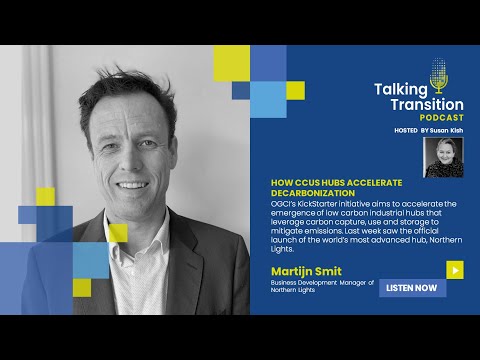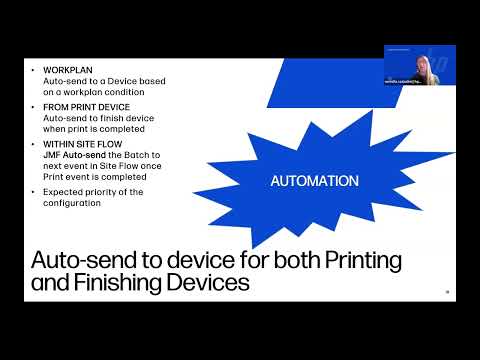Talking Transition podcast - episode 5: How CCUS hubs accelerate decarbonization

(upbeat music) - [Susan] Good morning. Good afternoon. Good evening. And welcome to OGCI's Talking Transition podcast series. I'm Susan Kish, and I'll be your host for the next 30 minutes.
This series looks at how the Oil and Gas Climate Initiative, or OGCI, works. What does the energy transition really mean? What are the hard questions? What are the messy issues and what are the challenges and opportunities that this transition may bring? We're gonna frame the conversation around what, around why, around who we're talking to today, and around how. We really appreciate your time as listeners and are gonna work to keep the conversation short and clear.
So let's start with the what. OGCI launched the Kickstarter Initiative in 2019 to help accelerate the emergence of large scale low-carbon industrial hubs around the world in order to leverage carbon capture use and storage, called CCUS and sometimes CCS, in order to mitigate emissions. These hubs capture carbon dioxide from industrial sources across a region, and then use experience, shared transport and storage infrastructure to bring costs down. Why? Well CCUS is one of OGCI and our member companies top priorities because it enables the energy transition in a lot of different ways. It can decarbonize industries like steel, cement, petrochemicals that currently have no scalable alternatives for decarbonization.
Two, it can provide low carbon gas power as a backup to renewables. Three, it can help kickstart the low carbon hydrogen economy. And four, it can create the infrastructure for carbon removal, taking carbon dioxide out of the atmosphere. And study after study that model the path to net zero include the concept of capturing and storing carbon at scale.
Although CCS investment tripled US dollars 3 billion last year, we're gonna need magnitudes more storage and projects to align with climate goals. So who. Who are we? Well, OGCI is composed of 12 companies from around the world who together account for almost 30% of global oil and gas production. At OGCI, they work together towards achieving net zero emissions. And who is our guest today? Martijn Smit is the business development manager of Northern Lights Project in Norway. Martijn's been with Equinor for over 15 years, managing upstream and downstream facilities as well as country operations.
So let's get to the heart of the conversation, Martijn. Welcome and thank you for joining us today. - [Martijn] Good morning, Susan.
It's a pleasure to be here. Thanks for having us. - [Susan] Delighted. So I'm gonna start with the basics. And first, congratulations.
I understand that the Northern Lights Project officially launched their JV last week to assume the lead on the project. So can you tell us what is the Northern Lights project and how's it gonna help accelerate decarbonization? - [Martijn] So Northern Lights is a industrial scale offshore CO2 storage facilities, which is set up linked with a ship-based solution. So this is the first in its kind in Europe, and we have secured final investment so we're actually constructing it now. What's very special about it is that it's also the first large scale CCS facility that has spare capacity that is marketed on its own merit.
So we are providing a solution for European industrials. And we're currently in discussions with industrials to collect CO2, basically, and to store it in Norway. So in this first phase, we are currently building this facility. It's 1.5 million tons on the onshore facility side. And we are already scaling the offshore part, the pipeline and the permanent geological storage, to 5 million tons per year. So we are three mother companies.
We've staffed up a joint venture from Shell, Total and Equinor. And as of last week, as you rightfully say, we even have our own company, own company name, own building, own IT infrastructure, own email addresses, and we are dedicated independent joint venture with the sole purpose to sell these transport and storage services to European industrials. As such, we try to set up a new value chain and business model, if you like, that should allow all the European countries to reach their climate goals and the individual companies to reach their net zero targets. So it's a new market and we are extremely excited about it. It'll be an exciting adventure going forward. - [Susan] It does sound.
It sounds like it's a lot of first there, and congratulations on the new email addresses. It is, as you say, one of those real sort of landmarks on the way to being independent for the mother companies. When is this gonna be in operation? When were you gonna start putting CO2 in storage? And it sounds like it's pretty deep. - [Martijn] Yeah, so the current construction project will be operational 2024. We have a 100 kilometers pipeline going off shore.
And then it's 2.5 kilometers down under the sea bed. And the sea is, at that location, is 300 meters deep, actually. So we are not going to a platform.
It will all be a submarine solution on the sea bed, and we collect power and et cetera from nearby offshore oil and gas platforms. - [Susan] So one of the things I was reading about for the project is this phrase, open source and open standards. Can you talk about what that means in this context? 'Cause I'm not used to hearing that kind of term for a oil and gas project. - [Martijn] We have Norwegian government backing us up and promoting, supporting this whole project. There's a public-private collaboration linked to it.
The geological storage in Norway is combined with a ship-based solution. So we basically supporting two industrials from Norway itself. So waste to power facilities and a cement factory close to Oslo in east of Norway. We have ships collecting the CO2 there and then sending to the west coast of Norway, 600 kilometers, where we offload the CO2 and then inject it offshore. We have spare capacity, as I said. So we will have additional ships that will collect the CO2 from anywhere in Europe.
So basically from Finland to Ireland to Germany, the Netherlands, Poland, France, Belgium, anywhere. If there is an offloading jetty at the port facilities in Europe, with this ship, we can pick it up and then inject it in Norway. So Norway has the history with the oil and gas industry. It has the knowledge of the sub-surface.
Who else could build this CO2 storages, right? We can construct it, we can build it. And countries that do not have the geology to store it, Belgium, France has less possibilities, they can access with ships the NCS. It unlocks the NCS for CO2 storage, is basically clearly for Europe. And there are other countries that have oil and gas experience that can also, and they are actually building CCS facilities as well. We're just slightly ahead on the first taking the FID.
UK, the Netherlands, Denmark are all having their projects but some countries don't have that easy access for pipeline solution. And the ship-based solution, therefore, provides a solution for industrials and countries to access the Norwegian continental shelf. - [Susan] And these places where you're storing the CO2, are these old now-empty oil wells, or what are these facilities that are almost three kilometers from the surface but, as you said, 2.5 kilometers under the seabed, what are these? - [Martijn] There are different models to it.
Northern Lights has a dedicated offshore license for CO2 storages. We have drilled a well, and it was a first well in that license, dedicated for injection immediately. That's pretty unique. You often see old oil or gas fields being used. And a third option that is being developed mainly in Iceland is where you store CO2 directly into basalts where it solidifies and reacts with the basalt.
But again, Northern Lights has a dedicated field in a sandstone formation with a lot of water and aquifer coal. And our whole CO2 chain consists of liquified CO2. Yeah, that's basically what we are doing in Northern Lights. When we grow, and if we succeed, old oil and gas fields is definitely also a possibility. - [Susan] Got it.
And when you say liquefied CO2, that must be very compressed, is that right? Is that how you get it to the liquid state? - [Martijn] Well, it's both pressure and temperature. It's not that high. For instance, our ships are around 15 bar, temperature, 30 degrees. So it's not that high pressure, high temperature.
but you look at the LNG ships, it's not... I think we actually use old LPG standard ships for this, and then adjust them for liquified CO2. - [Susan] How much does this cost? If I had to price out storing 100,00 tons, how do you quote it? Is it a fixed rate for eternity? Is it a solid rate for three, five years? How do you price this kind of service? - [Martijn] Well, it's a new value chain so the experience that that we bring, of course, is previous energy transition. In the past when you moved away from coal to natural gas and when you had to price natural gas it's kind of you're looking at the alternative options that are out there. For the CO2 pricing, the ETS is very relevant within the European context, where companies need to pay a price for CO2 emissions.
So that's where we're looking into. If the do nothing scenario is where you need to emit and you need to pay the ETS price. A number of countries in the EU have also set CO2 taxes in addition. So that gives us a benchmark for the pricing where there's currently a little bit of a value gap. So in Norway, like I said, we have the public-private collaboration. And part of the reason the Norwegian government is helping us out here is to kickstart this business.
We have the climate targets, we have the net zero ambitions of a lot of companies. We are convinced that without CCS we will never reach these climate targets and we need to get going quite frankly. And as you start going, on our side we will be able to reduce the costs as we learn and as we find ways to do things faster and better. And at the same time, we see that more and more countries in the European Union that ETS price is raising and also the national costs or taxation on CO2 are increasing. So that's how we are convinced there will be a commercial business model supporting the CCS going forward. But we're not there yet, Susan, to be honest.
We're not there yet. - [Susan] It does sound like you're in a new value chain and you're defining a new industry. So it's not surprising.
But one of the things I wanted to ask about is you mentioned earlier about net zero commitments and I'm just wondering if we talked about sort of the development when we talked earlier about your qualification as a project of common interest, and sort of the number of entities you were talking to in 2017, in 2019, in 2021. And I just wondered could you comment about how that interest has evolved over time, and does this increased emphasis on net zero commitments from countries and from companies, is it starting to be reflected in the amount of demand you have for the services you're offering at Northern Lights? - [Martijn] Yeah, it's a funny that you asked that because I think it's now just over a week ago that, we have every two years you need to renew a registration as a project of common interest, or if you've been involved in that, I can't be too specific about it because we have a non-disclosure agreement within the community, but what I can say is that the first registration we had in 2017, we had a renewal in 2019, now we have a new in 2021. So that, basically, we are growing in size in that community. And also the discussions that we have across Europe, I think we, I mean the amount of CO2 that is available, I think it's 30 million tons per year, easy, we have made an assessment through our ships. I think we could access over 300 million tons.
And then in the individual dialogues with companies that we actually talk to it, by 2030 it would be easily 35 million tons, will not be a problem at all. So the amount of industrials that faced increased costs from one side, have their own company strategies to go to address the climate and feel the pressure from society quite frankly for the license to operate within the EU is huge. It's absolutely huge. And we from Northern Lights experience it because we are constructing and we have the spare capacity available.
A number of other projects that are pre-FID but they may also see on those projects they are oversubscribed and sold out very rapidly. So the demand seems to be very high, much higher than the current supply - [Susan] Which is a good thing from the perspective of developing a new value chain, right? - Absolutely. - This is not just an issue of the license to operate but also sort of the global competitiveness for the industries you've talked about, and ensuring that they're able to compete both to supply within Europe but to play on the global stage. If you're the steel industry in Europe and you're looking to remain competitive on the global stage, but you've got pretty strict requirements around carbon emissions, how important is a facility such as yours in keeping them competitive? - [Martijn] Part of the interest that we see and the attention that we get comes from that point that they do not have that many solutions or options.
And they do feel the heat of the license to operate, prices increasing, taxes increasing, and their management or the shareholders asking for a lower emissions strategy and more sustainable production within their own companies. So that's why we are convinced CCS has to be a part of the toolbox to meet the climate targets. And that's what we see also in the response from the market. - [Susan] Northern Lights isn't providing services to do the capture, right? You just take the, quote unquote, pure carbon dioxide and transport and store it.
- [Martijn] Yes. We load it onto our ships. We own the ships and then we bring it to Norway. So the capture part is something for the industrials to organize themselves.
And a number of players in that field, it's also an evolving market, but some industrials like the beverage industries buys CO2. So there is already an existing market for CO2 in that perspective. So we talk to a very wide spectrum of, basically, players. Some are very experienced in it and for some it's really a mission and a new. - [Susan] So just talk about the capture.
One of the other things I read that you did last week is you signed an agreement with Climeworks, the Swiss company that does direct air capture, about exploring installing a direct air capture plant in western Norway, close to the terminus for the offshore storage. How does direct air capture interact with the model that you've got? - [Martijn] That is a collaboration we are extremely enthusiastic about. So the direct air capture basically means that you take the CO2 directly out of the atmosphere and that you inject it. This is a technology. Of course, trees do this all the time, right? So direct air capture and also bio CCS, where you use trees or feed stock for power and then store that CO2, these both are extremely important technologies because they, what we call, bring negative emissions.
You have a net sink of CO2 away from the atmosphere which is, in our view, is the future, right? Because we are talking about reducing the emissions all the time but to reach the climate targets, at the end of the day, we need to get out to negative emissions and reduce it. And these two technologies are the ones that will help us succeed in that direction. So we're very enthusiastic about that collaboration and that's technology that we also need to further develop and seek to reduce costs on.
- [Susan] Very cool. So just as a closing question, it feels as if CCS, it isn't a new technology, right? That some of the core parts of CCS have been around for 20, 30 years. And I think Equinor actually has been doing it for quite a long time. - [Martijn] The technology is there and experience is there.
It's been monitored for 25 years. You can see the CO2, how it behaves in the sub-surface. People have been knowing about it for a long time. And the reason why it hasn't picked up earlier maybe is exactly the relative costs of it, potentially. So that's part of the reason why the Norwegian government is supporting this full value chain to kickstart this market and maybe build a bit on the offshore wind development. Costs came down so quickly once they started working in.
We're convinced that once we start working on this, costs will come down. We will find better ways of doing things. And at the same time, we also strongly believe that the price for emissions will go up. So the early days, maybe some public-private collaborations will be needed. But in the future we strongly believe that if only private money, this should be a profitable business in the CO2 storage.
And let's not forget the direct air capture and the bio CCS negative emissions. These carbon credits are being traded and that's a developing market in its own right. So we strongly believe in the future for this new market. And let's just go out there and do it and develop it together. - [Susan] Well, you're making it sound like it's the perfect storm. We're at a tipping point where the demand side and the supply side coming together, and the urgency helps give that little extra push.
And it does sound like this Norwegian government played a critical role. But let's go to the question about you. Martijn, you've worked all over the world. You've been in oil and gas.
You studied. You're a geologist by training with a degree in business management. Why are you doing this project? What brought you to Northern Lights? - [Martijn] Well, there's not one answer to that question, I think, but one element definitely is that I have three teenager kids and they challenge their father every now and then.
Is it really necessary to sit in business class and fly to Africa or Latin America to talk about oil and gas? Then COVID came so stranded back home and you think about, what am I really gonna do? And I think this time around, the whole society and you see everybody's talking about the climate, that it's becoming more important. My company has a net zero target. So I'm just really keen to contribute to the net zero and address the climate. When this opportunity came by, and being a geologist, I strongly believe in the CCS. I think it's possible. I think it is safe.
We've done it for many, many years. There's huge potential and we've talked about it for long enough. We can do it.
And we would like to demonstrate we can do it. And that's basically how I got into it. I'm really keen to deliver on this and make this a big success. - [Susan] Well, congratulations on the project and where it is. We're gonna look to supporting it as we can.
And thank you for spending time with us today, Martijn. - [Martijn] It was a pleasure. Thanks for having us. - [Susan] Thank you. I'd like to close by saying thank you to Martijn again. Thank you to their colleagues at the Northern Lights Project, as we looked at where the project is, its progress to date, the challenges and opportunities that that project faces For more information around the project and around OGCI, please visit our website, oilandgasclimateinitiative.com.
We have information about the Northern Lights Project and other projects in the Kickstarter program. And on our next Talking Transition, we're gonna talk` about the report about potential for this technology for CCS in Saudi Arabia and across the Gulf states with Tegeon Denias. To follow what OGCI and OGCI Climate Investments are doing, OGCI Climate Investments is our billion plus fund that invest to accelerate decarbonization. And they've been active in CCS since 2017, both with technologies and a portfolio of projects in the UK and North America. So please do follow us on LinkedIn and on Twitter at OGCI News. Thank you for listening to today's Talking Transition podcast.
We would be grateful if you could rate, review, subscribe, recommend this broadcast on the platform where you're listening to us. And we will listen carefully to your feedback, your comments, your suggestions and new hard questions for us to examine. And finally, thanks to our production team here at OGCI, to our editor for this edition, Delia Meth-Cohn, and to our producer, Jason Dela Cruz, and thank you to everyone. Stay safe and good morning, good afternoon, good evening.
2021-03-24 13:24


